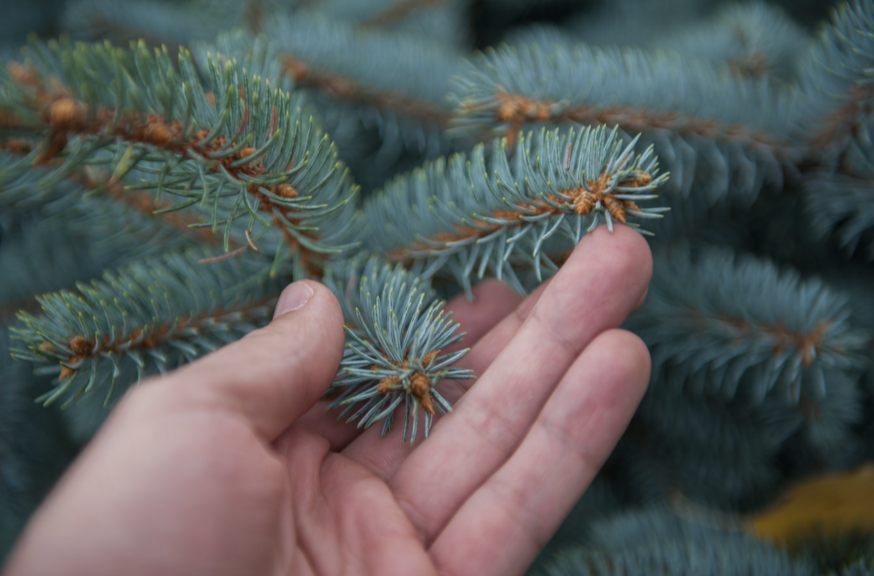This year I came full circle with fresh-cut Christmas Trees. It went from a beloved family tradition in my younger years to something that stood for everything that was wrong with humans and nature (take, take, take) in my late teens and 20’s, up to this year.
The thing that changed for me had to do with a big perspective shift (and a little web research). This new paradigm looked at fresh-cut organic and wildcrafted Christmas trees as big houseplants and diffusers.
A tree brought indoors functions like an enormous houseplant. It’s like having a living air filter and humidifier in a dry winter home. As it draws water up its trunk, it diffuses moisture out into the room, humidifying the air and also releasing essential oils into the surrounding atmosphere.
This natural humidifier works to moisten dry winter air that for me usually causes dry-cracked skin and sometimes bloody noses. Additionally the volatile essential oils that come from Pine and Fir Trees boost immune function among other things:
Scotch Pine Essential Oil:
Douglas Fir Essential Oil:
Douglas fir helps to reduce cellulite, promotes mental health, clear sinuses, soothes exhausted nerves, aids communication and acts as an effective painkiller. It can also benefit in severe breathing conditions, infections and problems with the respiratory system.[2]
After this perspective shift in looking at Christmas Trees as medicinal houseplants and all the benefits they provide, I still had concerns about the environmental impact of cutting down approximately 25-30 million real Christmas trees just in North America. Upon further research, I found that, “Luckily, about 93 percent of those trees are recycled through more than 4,000 available recycling programs.” [3]
After reading about tree recycling and carbon sequestration, I was feeling really positive about the Christmas Tree industry, but I still wondered about pesticides and whether Artificial Christmas Trees were better for the environment given their yearly re-use and assumed longevity. This is what I found:
So, Artificial Trees were definitely out after finding that information, but what about the pesticides used to grow living Christmas Trees?
Beyond Pesticides states that just 1% of all Christmas trees sold in the U.S. are organic. The also note that, “Pesticides found in conventionally grown Christmas trees are linked to numerous adverse health effects, including cancer, hormonal disruption, neurotoxicity, organ damage, reproductive/birth defects, asthma, and more.”[5]
After reading this, I was a little discouraged, but then I found that organic Christmas Trees do exist and there are resources available on where to find them. Additionally, if you are lucky enough to live in a more remote forested area, cutting down your own tree may be the best option of all. Not only do you get some exercise and connect with nature, but you can help steward the land by thinning out smaller trees to allow others to grow to maturity.
After taking everything into account, I’ve decided that if I’m going to celebrate Christmas with a tree, I’m going to do so with a living organic tree or wildcraft my own Charlie Brown Tree and shift my guilt to gratitude by honoring the tree for the medicine its bringing into my home and heart.
Organic Christmas Tree Finding Resources:
- Green Promise: Maintains a list of organic Christmas Tree Farms covering many U.S. states.
- Silvertip Tree Farm: Sustainable farm currently working towards their organic certification, plus will ship a real tree to your home!
- Local Harvest: Has a list of where to find local, safer tree farms.
Article Resources:
- https://essentialoilbenefits.org/scotch-pine-essential-oil/
- https://essentialoilbenefits.org/douglas-fir-essential-oil/
- https://earth911.com/home-garden/real-vs-artificial-christmas-trees/
- https://earth911.com/home-garden/real-vs-artificial-christmas-trees/
- https://beyondpesticides.org/index.php

1 thought on “Christmas Tree Medicine”
Pingback: DIY Flying Wish Paper - Non-toxic! - Mary Wutz